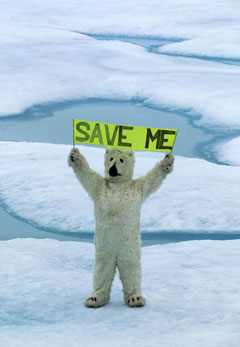U.S. lists the polar bear as threatened, but decision won’t affect emissions rules
U.S. lists the polar bear as threatened, but decision won’t affect emissions rules
mongabay.com
May 14, 2008
|
|
The U.S. Interior Department has decided to list the polar bear as a threatened species due to declining sea ice cover in the Arctic. The decision comes a day before a court-imposed deadline to decide whether the polar bear should be protected under the Endangered Species Act.
The listing could force the U.S. government to take measures to protect the bear’s Arctic habitat which scientists say is melting partly as a result of the build up of greenhouse gases in the atmosphere. Such measures may include a cap on carbon dioxide emissions, though Dirk Kempthorne, Secretary of the Department of the Interior, discounted the possibility in a press conference announcing the decision.
“Listing the polar bear as threatened can reduce avoidable losses of polar bears. But it should not open the door to use of the Endangered Species Act to regulate greenhouse gas emissions from automobiles, power plants, and other sources,” Kempthorne said. “That would be a wholly inappropriate use of the ESA law. The ESA is not the right tool to set U.S. climate policy.”
Still environmentalists applauded the news.
 Photo courtesy of Greenpeace |
“This decision is a watershed event because it has forced the Bush administration to acknowledge global warming’s brutal impacts,” said Kassie Siegel, climate program director at the Center for Biological Diversity, and lead author of the 2005 petition. “It’’s not too late to save the polar bear, and we’ll keep fighting to ensure that the polar bear gets the help it needs through the full protections of the Endangered Species Act. The administration’s attempts to reduce protection to the polar bear from greenhouse gas emissions are illegal and won’t hold up in court.”
“The polar bear is the poster child of climate change and we need to do all we can to protect this species from the effects of global warming,” said Dr. Steven E. Sanderson, President and CEO of the Wildlife Conservation Society. “Alaska’s polar bear population is particularly vulnerable to climate change and deserving of greater federal protection. We applaud the USFWS to list the bears as threatened under the Endangered Species Act.”
Polar bears at risk from melting sea ice
Researchers say the polar bear is at risk due to melting sea ice. In September, biologists with the U.S. Geological Survey warned that the United States and Russia will likely lose all of their polar bear populations due to thinning and disappearing sea ice by 2050. The loss would amount to around two-thirds of the world’s population of the species.
Field reports indicate that drowned polar bears are being found for the first time in Alaska. Researchers speculate that greater distances between ice sheets could be taking a toll on the bears. While bears are capable of swimming long distances–up to 60 miles (100 km) without stopping–it is conceivable that they could suffer from exhaustion during an unexpectedly arduous swim. A shorter spring hunting season caused by progressively earlier breakup of sea ice, reduces the chances of reproductive success for female polar bears and makes it more difficult for bears to find food.
In December, scientists speaking at the American Geophysical Union meeting in San Francisco warned that summer sea ice could disappear in the Arctic within five years. Both Greenland and Arctic sea ice are melting at record rates, with Greenland’s ice sheet losing 19 billion more tons of ice than ever recorded and summertime Arctic sea ice volume declining by 50 percent over the past four years.
Melting in the Arctic was so extensive last summer that the fabled Northwest Passage was open to navigation for the first time on record. Scientists say the Northeast Passage — north of Russia — may soon also be navigable due to disappearing sea ice.
The melting has set off a scramble between Canada, Russia, the U.S., Denmark, Sweden and Norway which are all seeking to claim rights to the Arctic’s rich mineral and gas deposits. Some companies are concerned that the polar bear’s listing as a threatened species could thwart efforts to develop the region’s oil and gas reserves.